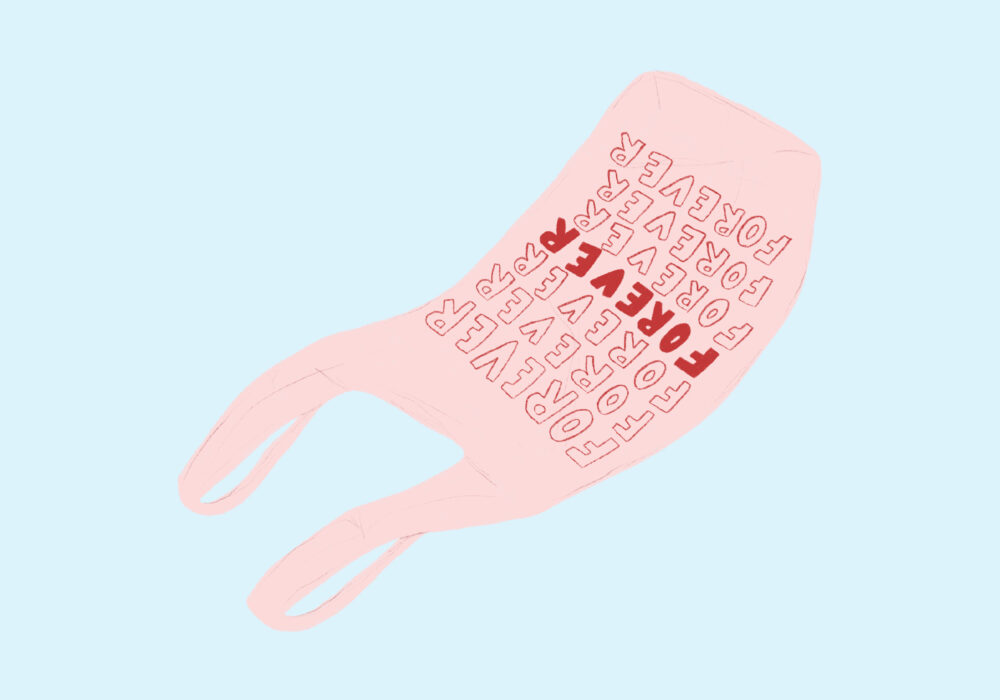You’re walking from the subway to your NYC studio apartment. It was a long day at work and you don’t feel like cooking dinner, so you stop for takeout. Ten minutes later you’ve got green curry and spring rolls swinging by your side in a bag printed with seven red thank you’s. You unpack it onto your countertop. As the smell of lemongrass and coconut wafts through the room, you ball up the bag and throw it in the trash.
The plastic bag you just tossed lived and died in the time it took you to walk home from the restaurant, but it will remain on this earth for many lifetimes over. Scientists estimate that lightweight polyethylene bags take about 1,000 years to degrade in a landfill. There’s no way to know for sure, though, because we didn’t have the technology to create them until 1953. Not only does every plastic bag ever made still exist in some form in the environment today, but it will persist with a fervor almost beyond comprehension.
“At their most useful, [plastic bags are] intermediaries, used to transport goods from one place to another, which means that, at their most useful, they’re hallmarks of our collective laziness, our refusal to plan ahead and to consider consequences beyond our own immediate inconvenience,”
says Maya Moverman, a photographer and yoga teacher who lives in Manhattan, where plastic bag litter is omnipresent.
New Yorkers will soon be forced to reckon with this inconvenience when a recently passed statewide ban goes into effect in March 2020. New York is the third state in the U.S. to ban retailers from offering single-use plastic bags, following California and Hawaii. It is up to individual counties to decide whether to impose a 5-cent fee on paper bags, 40 percent of which goes towards buying reusable bags for low-income consumers. The remaining 60 percent supports the state’s Environmental Protection Fund.
Lest we start to dream of a New York where all plastic bags have been replaced by recycled nylon Baggus and New Yorker totes, many types of single use plastic bags will still be permitted under the ban. These include sleeves for produce and bulk items, deli counter bags, takeout bags at restaurants, garment bags, newspaper bags, and trash bags. That is to say, New York still has a long way to go.
Plastic Habits Die Hard
“As a transplant from Los Angeles, it was shocking to me to see how much plastic was still in use in NYC when I moved here three years ago,”
says Jen Hung, a Brooklyn based chef and writer. For a city that fancies itself woke, it is perplexing how single-use plastic bags still pervade—handed to bodega customers at the checkout line, hanging by the hundreds on street vendor carts, twisted into tree branches, and floating across sidewalks.
Changing behaviors around bag use is more challenging in New York than somewhere like California where people can keep their cars stocked with reusable options. If you’re out buying food in NYC you need to have taken bags with you when you left your apartment, which was likely hours earlier.
California has taken a stronger approach to denouncing the disposable carry-all. Its ban includes both thin and thicker plastic bags and imposes mandatory fee on paper bags. “That hybrid has proven to make people change their behavior,” says Patrick Diamond, the NYC Vice Chair of Surfrider Foundation, a national nonprofit dedicated to ocean conservation. This is partly because it more aggressively curbs consumption of paper bags, which weigh more than plastic, so they require more energy to transport and lead to heavier waste for the city to deal with. NYC has opted into the 5-cent fee for paper bags, but other counties around the state have not.
If a shopper has to choose to opt in or opt out of a bag it prompts them to think critically about the decision rather than default to taking one. A survey conducted by the Alameda County Waste Management Authority in 2014 showed that if shoppers didn’t bring a bag to the grocery store and only bought a few items, they were more likely to carry those items loose to their car than pay the 10-cent fee that is mandatory in the county. Whether the decision is motivated by financial or environmental concerns, it is these subtle shifts that lead to the normalization of more sustainable behaviors.
“I think the bag bans actually do a really good job at that first level of normalization,” says Adrienne Habiger, who worked as an associate for the Alameda County Waste Management Authority before receiving her master’s degree in public policy. “Ten years ago it would have been really weird to take your canvas bag and plop it down at checkout.”
Switching to reusable bags is a “low hanging fruit behavior change,” Habiger says—a shift that isn’t too challenging for most people and can be a stepping stone to others like bringing your own coffee cup or to-go container to restaurants.
“We are convenience and consumption obsessed in NYC,”
says Diamond. The fact that you can buy anything you need throughout the day and throw it away when you’re done is a central facet of the lifestyle. But even one small behavior change can make a huge difference when it’s multiplied by 8.5 million New Yorkers.
The need for alternatives that don’t ask consumers to sacrifice too much convenience is also an opportunity for innovation. “As long as these things are moving forward, it creates a market for new creative ideas around plastic waste reduction,” says Habiger. Take GO Box, a Portland startup providing city dwellers with reusable takeout containers that they can use at food carts and restaurants, then leave at a drop site where it’s collected to be sanitized and used again. Considering the fact that 67 percent of litter in commercial streets is comprised of single use disposable food and beverage packaging, NYC could be a good market for a similar program. “Solutions like that are borne out by people really pushing for the change,” says Habiger.
What You Can Do
As education around the impact of plastic becomes more widespread, individual choices are driving the movement forward alongside policy action. All it takes to avoid single-use plastic in NYC is some preparation in advance—tossing a reusable coffee cup, water bottle, and tote in your bag in the morning, keeping utensils and a cloth napkin at your desk.
“The most important thing is to educate yourself and be a thoughtful consumer,”
Diamond recommends. If you already have your zero-waste kit in tow, make sure you’re registered to vote, read up on candidates’ positions on environmental issues, and speak to elected officials. “Just insert yourself in the process,” he says.
Single-use products like plastic bags were designed to make life easier for all of us, but the extent to which they’ve permeated our day-to-day would probably seem outlandish to someone in the 1950’s when they first entered the market. In a remarkably short period of time, we’ve come to believe that we wouldn’t be able to function without the convenience of a disposable shopping bag, a coffee cup that can be tossed as soon as it’s empty, or a lunch container that you don’t need to bring home at the end of the day.
The value we receive from these products is dwarfed by the eons of harm they cause to our planet. Attempting to do away with a piece of New York City culture as ubiquitous as plastic bags may seem futile today, but perhaps this effort will make the idea of being reliant on them seem just as ludicrous to future generations.


